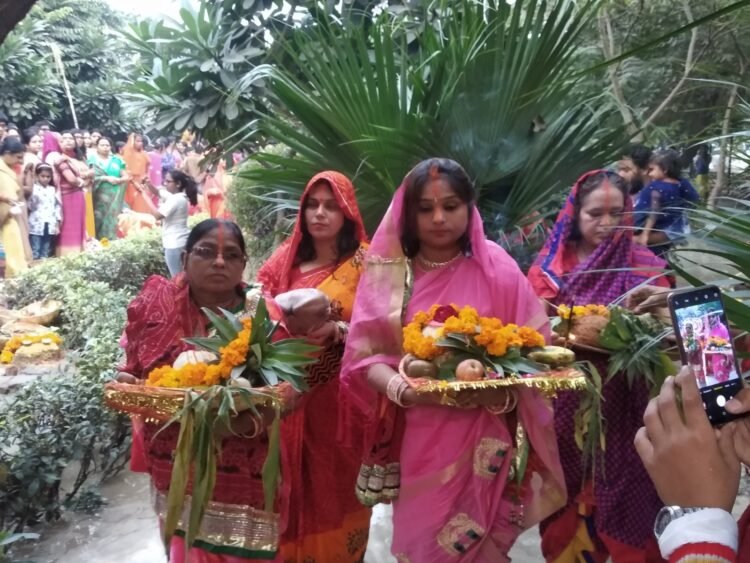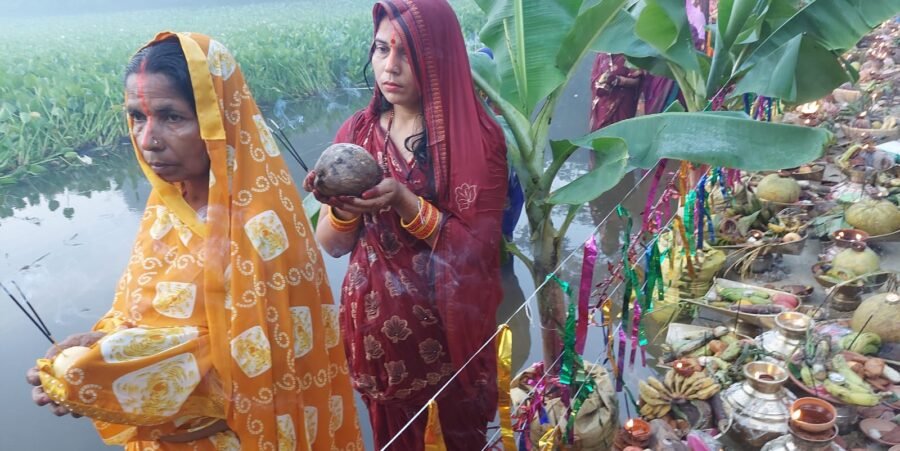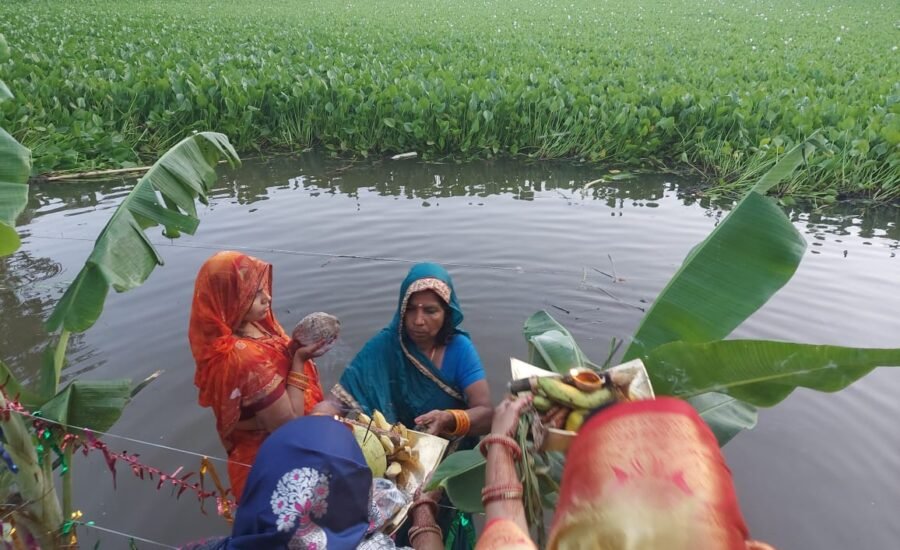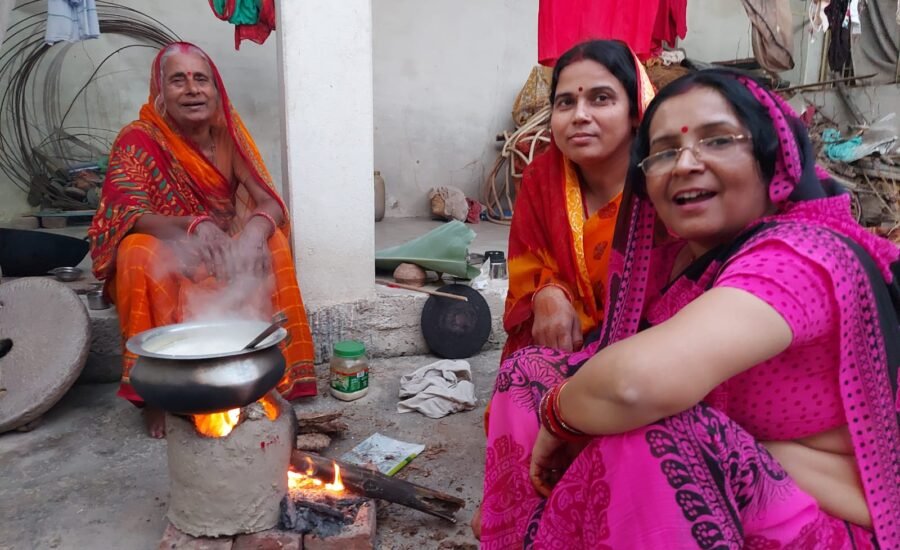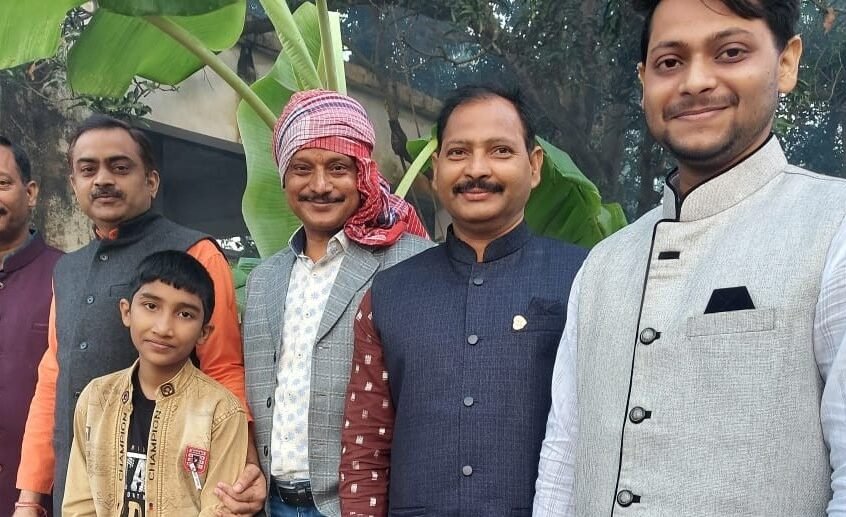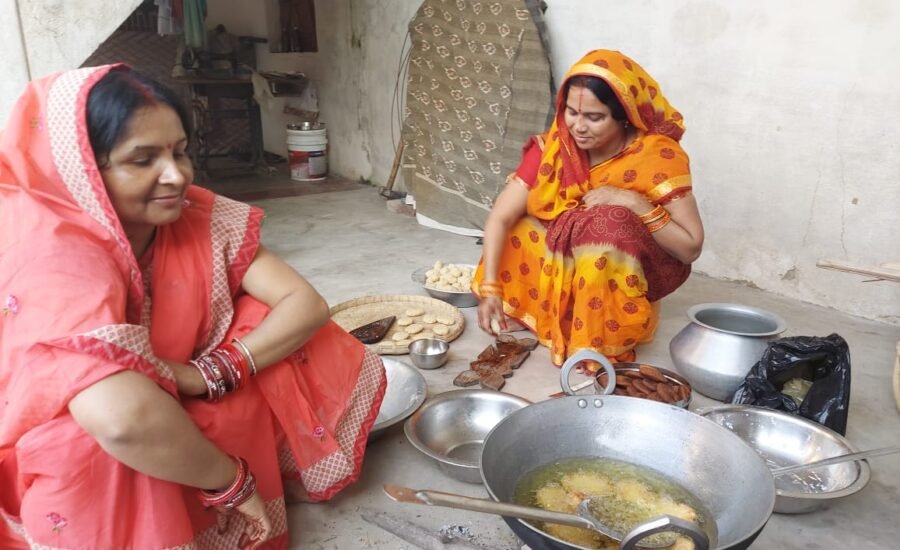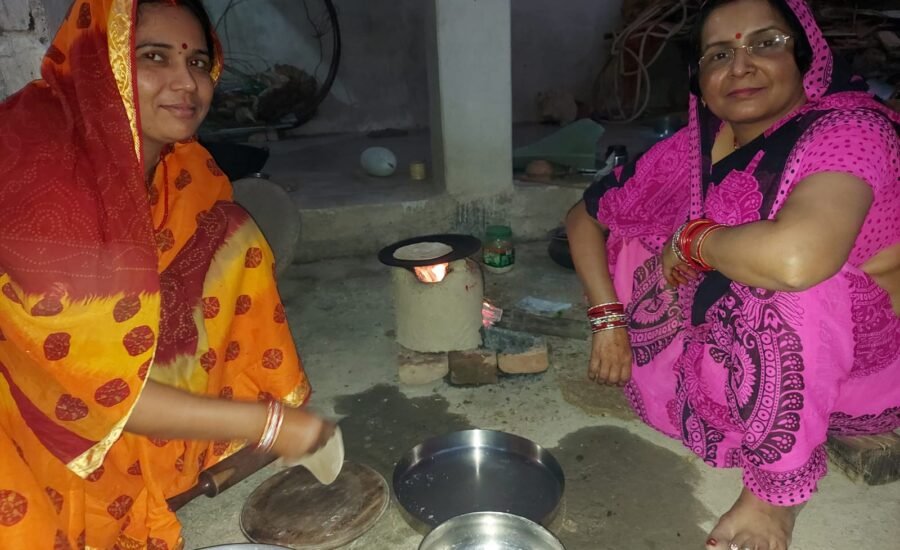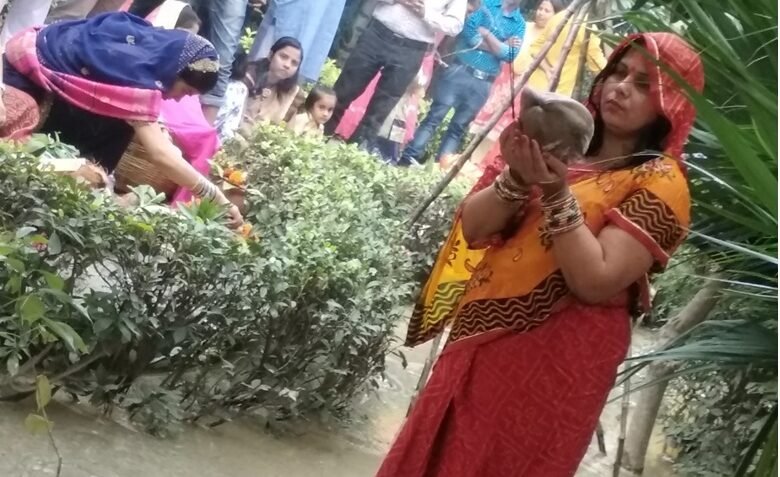No products in the cart.
Chhath Puja -An Exquisite of Faith, Purity, and Nature Worship
The entire atmosphere of Chhath resonates with purity, folk music, nature, and community spirit—where religion and nature unite harmoniously. It is a living celebration of the bond between humans and nature.
By Akhilesh Chaudhary

The great festival of Chhath, known as the festival of folk faith, is a remarkable example of the simplicity, discipline, and deep reverence toward nature inherent in Indian culture. This festival is dedicated to Lord Surya (the Sun God) and Chhathi Maiya (Goddess Shashthi)—believed to be symbols of health, fertility, and prosperity.
Primarily celebrated in Bihar, Jharkhand, Eastern Uttar Pradesh, and the Terai regions of Nepal, Chhath Puja is observed with immense devotion and purity. Today, through the Indian diaspora, this festival has spread to London, Dubai, the USA, Mauritius, Fiji, Nepal, and beyond, becoming a global symbol of Indian cultural identity.
Cultural Significance
Chhath Puja embodies the essence of Indian culture — simplicity, discipline, and self-restraint. It requires no grand temple or idol, and no priest is needed; devotees perform the rituals themselves.
The devotees (known as Vrati) follow strict rules for four days, maintaining utmost purity, restraint, and self-control.
The entire atmosphere of Chhath resonates with purity, folk music, nature, and community spirit—where religion and nature unite harmoniously. It is a living celebration of the bond between humans and nature.
Offerings and Ritual Materials
The offerings (Prasad) of Chhath are not mere food items; they symbolize purity, labor, devotion, and faith. The materials used are deeply rooted in folk traditions and eco-friendly lifestyles.
Traditional items include:
- Dalā/Daurā (bamboo baskets),
- Supa/Daliya (flat winnowing tray made of bamboo or leaves),
- Sarbī (small earthen pot), and
- Kurbar (large earthen vessel).
The Supa is used to arrange offerings like fruits and sweets and carry them to the riverbank.
The Dala or Daurā holds the complete set of ritual materials.
The Sarbī contains rice, Thekua, Khajuri, and Kasar, while the Kurbar holds Chura, Thekua, Khajuri, Kasar, sugar sweets, and various fruits—used while offering Arghya (water offerings) to the Sun God and Chhathi Maiya.
Main blessed food
The key offerings of Chhath Puja are Thekua, Kasar, and Khajuri, each carrying deep symbolic meaning.
- Thekua – Made from wheat flour, jaggery, and ghee, often flavored with fennel, cardamom, and coconut shavings. It symbolizes devotion, purity, and effort.
- Kasar – A traditional sweet powder made of rice flour, fennel, ghee, black pepper, and jaggery/sugar, sometimes shaped into laddus. It signifies sweetness and sanctity, forming an essential part of Bihar’s Chhath offerings.
- Khajuri – Prepared from refined flour, semolina, ghee, and dry fruits, and offered with the same devotion as Thekua.
Fruits and Natural Offerings
The fruits and materials offered during Chhath represent nature’s abundance:
- Banana bunches, tender coconuts, five sugarcane stalks (with leaves), yam, sweet potatoes, radish, large lemons, water chestnuts, pears, apples, and other seasonal fruits.
Each symbolizes fertility, prosperity, purity, and health, making Chhath not just worship of deities, but also a celebration of nature’s generosity.
Other Sacred Items
Other ritual materials include ginger plants, betel leaves and nuts, raw turmeric, sprouted grains (Ankuri), lamps, incense, vermilion, rice, sacred water (Ganga jal), and milk.
The sprouted grains (Ankuri) are especially significant—they represent the Sun’s energy and the Earth’s life-giving power, and are offered during the Arghya ceremony.
Soul of Folk Songs
The spirit of Chhath lives in its folk songs sung in Bhojpuri, Magahi, and Maithili dialects. These songs express devotion, gratitude, family affection, and love for nature.
Famous lines like:
“Ugi He Suraj Dev, Argh ke Ber Ba…”
“Kelwa ke Paat Par Ugle Suraj Dev…”
“उगी हे सूरज देव, अरघ के बेर बा…”
“केलवा के पात पर उगले सूरज देव…”
are not just prayers but heartfelt hymns echoing faith, humility, and devotion. They reflect wishes for children’s welfare, family prosperity, and the beauty of nature—carrying the cultural spirit through generations.
Worship of Nature
Chhath is not limited to Sun worship alone—it honors water, air, earth, and the entire natural world. Devotees stand for hours in rivers or ponds offering Arghya, symbolizing respect and surrender to nature.
Mythological and Historical Aspects
- The roots of Chhath Puja trace back to Vedic times, where the Rigveda describes the Sun as the “healer of all ailments” and the source of life.
- In the Mahabharata, Draupadi performed the Chhath fast on sage Dhaumya’s advice, restoring the Pandavas’ lost kingdom.
- Karna, the son of the Sun God, used to stand waist-deep in water offering Arghya to his father every day—an enduring example of devotion and discipline.
- According to legend, King Priyavand, who had no children, performed Chhath Puja on Sage Kashyap’s advice and was blessed with a healthy son by the grace of Goddess Shashthi (Chhathi Maiya)—the goddess of fertility and health.
The Tradition of “Thadhia” and Male Participation
Chhath is not confined to women; men also observe the fast with equal devotion and discipline. They pray for family welfare and stand in water offering Arghya to the Sun.
The term “Thadhia” refers to the sacred act of standing in water during the ritual—symbolizing patience, faith, and endurance.
Following Karna’s example, devotees stand waist-deep in water, offering Arghya to the Sun, signifying discipline and devotion.
Scientific Significance
- Standing in water enhances immunity.
- Morning and evening sunlight provides beneficial ultraviolet rays, helping the body produce Vitamin D.
- The reflection of sunlight on water balances energy in the body.
- The process of fasting purifies the body (detoxification) and calms the mind.
- The rhythmic timing of Arghya (sunrise/sunset) maintains the body’s biological clock.
- The use of natural materials promotes environmental awareness and plastic-free practices.
Purity and Mental Strength
Meditation and prayer while standing in water bring mental clarity and emotional stability. Men now equally participate—preparing Prasad, decorating ghats, and performing rituals—transforming Chhath into a festival of gender equality and collective devotion.
Social Aspect
Chhath is a festival of equality and community spirit. People from all castes and classes join hands to clean and decorate ghats and distribute offerings together.
Rich and poor alike stand in the same line offering Arghya—a symbol of social harmony and spiritual democracy.
It also celebrates womanhood and inner strength, as women observe rigorous fasts and worship in water, embodying devotion and endurance.
Scientific and Environmental Perspective
Chhath is both spiritual and ecological in nature:
- Sunlight during Kartik Shukla Shashthi and Saptami is soft and therapeutic.
- The fasting process detoxifies the body.
- Eco-friendly rituals emphasize nature conservation, clean rivers, and plastic-free worship.
- The peaceful environment of music, meditation, and nature reduces stress and promotes emotional well-being.
Four-Day Ritual Tradition
- Nahay-Khay (Day 1): Begins with a sacred bath and a simple vegetarian meal (pumpkin, rice, and lentils). Purity of home and food is maintained.
- Kharna (Day 2): Devotees fast all day, breaking it in the evening with jaggery pudding (kheer) and roti—then begin a 36-hour waterless fast.
- Sandhya Arghya (Day 3): Offering water to the setting sun at riverbanks with deep devotion.
- Usha Arghya (Day 4): Offering to the rising sun, marking renewal and hope. The fast concludes (Paran) with water, rice, ginger, fruits, and Prasad, symbolizing spiritual fulfillment.
Chhath is not merely a religious observance—it is a philosophy of life, symbolizing the harmony between humanity, divinity, and nature.
From the purity of Nahay-Khay, the devotion of Thadhia, to the serenity of Usha Arghya, every ritual signifies balance, renewal, and purity of life.
Chhath reminds us that true worship lies not in grandeur, but in simplicity, discipline, and harmony with nature.
Through its rituals and songs, Chhath keeps alive the Indian ideals where faith and science, women’s strength and men’s penance, devotion and ecology flow together in unity.
Hence, since ancient times, Chhath has not just been a festival of faith, but a celebration of life itself—a living symbol of Indian culture, ecological balance, and social unity.
#Chhath_Mahaparv #Bihar #Uttarpradesh


